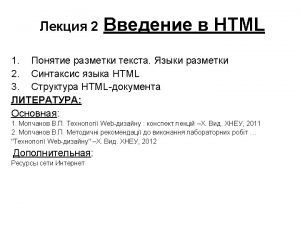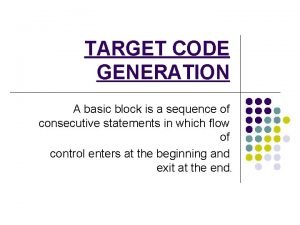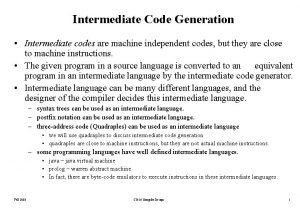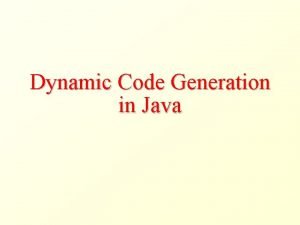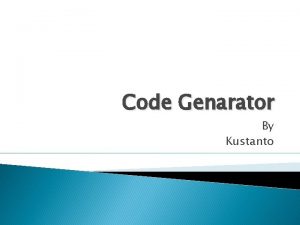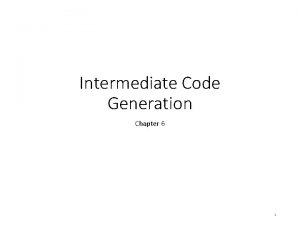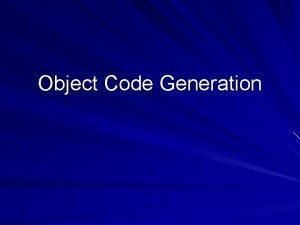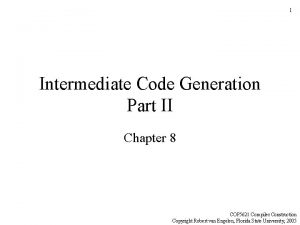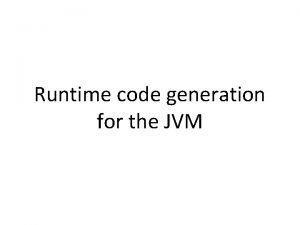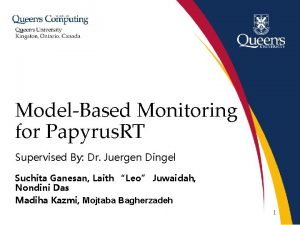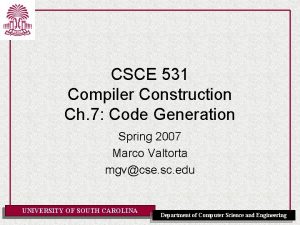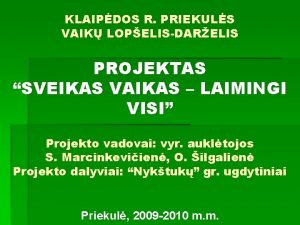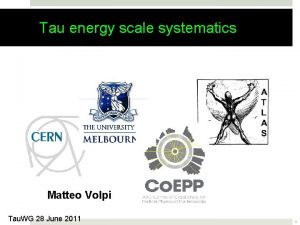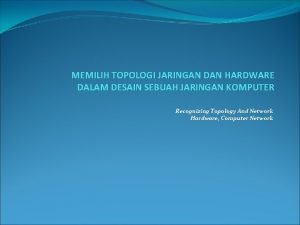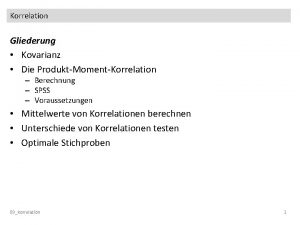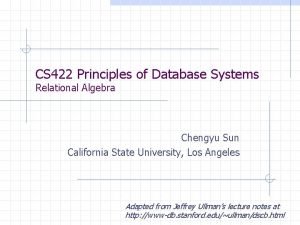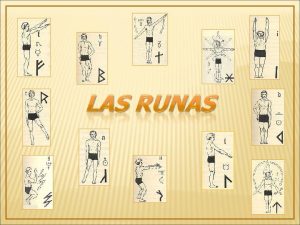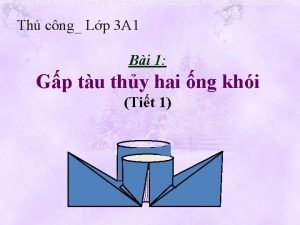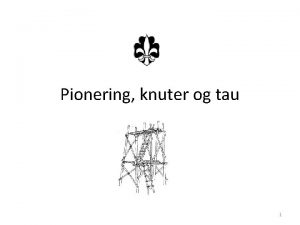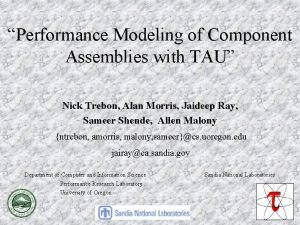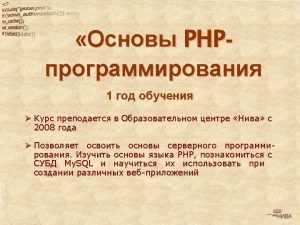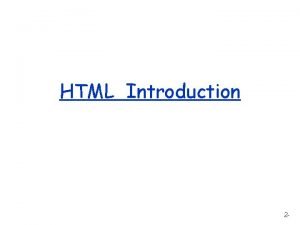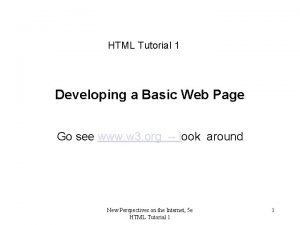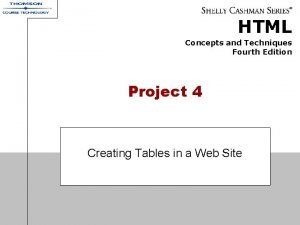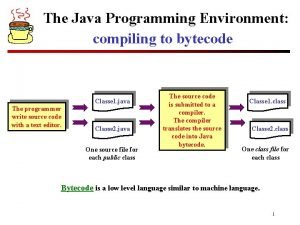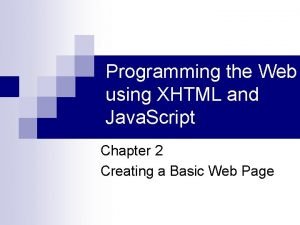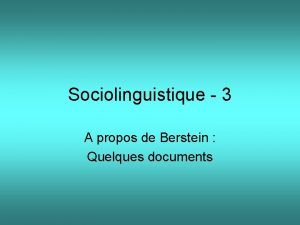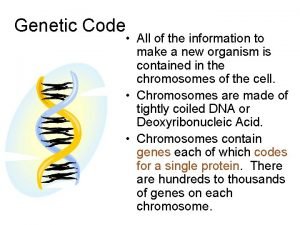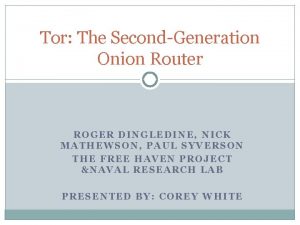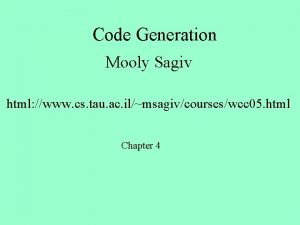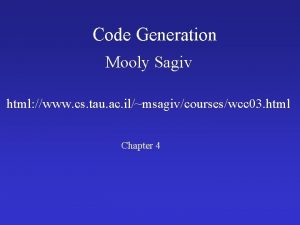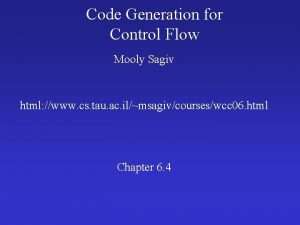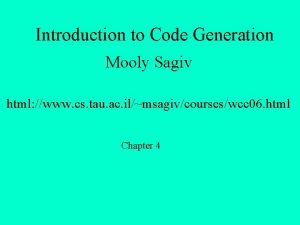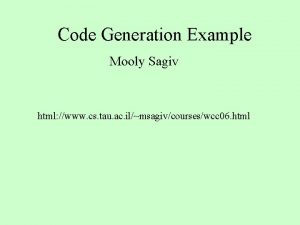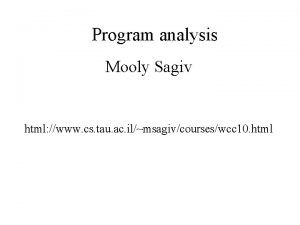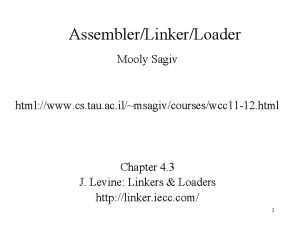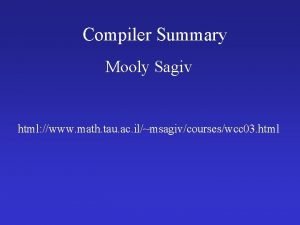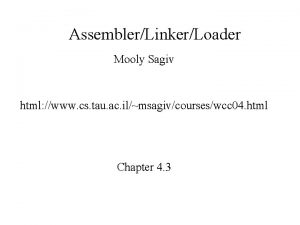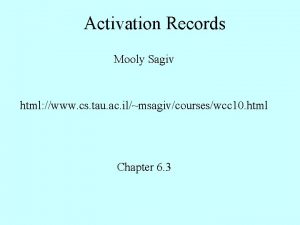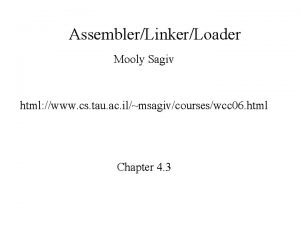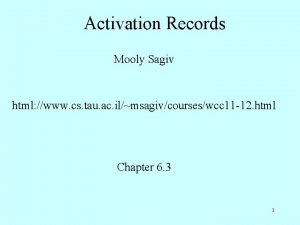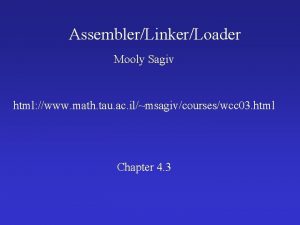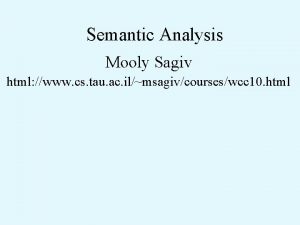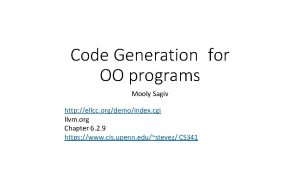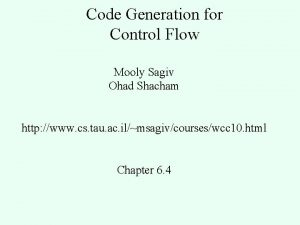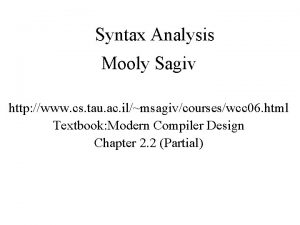Code Generation Mooly Sagiv html www cs tau




![a : = (b[4*c+d]*2)+9 a : = (b[4*c+d]*2)+9](https://slidetodoc.com/presentation_image_h/097fe044d53cdbfe88aef957dfd70d0a/image-5.jpg)


![Ra + * Rt Load_Byte (b+Rd)[Rc], 4, Rt 9 2 Ra + * Rt Load_Byte (b+Rd)[Rc], 4, Rt 9 2](https://slidetodoc.com/presentation_image_h/097fe044d53cdbfe88aef957dfd70d0a/image-8.jpg)
![Ra Load_address 9[Rt], 2, Ra Load_Byte (b+Rd)[Rc], 4, Rt Ra Load_address 9[Rt], 2, Ra Load_Byte (b+Rd)[Rc], 4, Rt](https://slidetodoc.com/presentation_image_h/097fe044d53cdbfe88aef957dfd70d0a/image-9.jpg)





















































































- Slides: 94

Code Generation Mooly Sagiv html: //www. cs. tau. ac. il/~msagiv/courses/wcc 10. html Chapter 4

Tentative Schedule 23/11 Code Generation 30/11 Activation Records 7/12 Program Analysis 14/12 Global Register Allocation 21/12 Assembler/Linker/Loader 28/12 Garbage Collection 4/1 Object Oriented Programming 11/1 Functional Programming

Basic Compiler Phases

Code Generation • Transform the AST into machine code – Several phases – Many IRs exist • Machine instructions can be described by tree patterns • Replace tree-nodes by machine instruction – Tree rewriting – Replace subtrees • Applicable beyond compilers
![a b4cd29 a : = (b[4*c+d]*2)+9](https://slidetodoc.com/presentation_image_h/097fe044d53cdbfe88aef957dfd70d0a/image-5.jpg)
a : = (b[4*c+d]*2)+9

leal movsbl

Ra + * 9 mem 2 + @b + * 4 Rd Rc
![Ra Rt LoadByte bRdRc 4 Rt 9 2 Ra + * Rt Load_Byte (b+Rd)[Rc], 4, Rt 9 2](https://slidetodoc.com/presentation_image_h/097fe044d53cdbfe88aef957dfd70d0a/image-8.jpg)
Ra + * Rt Load_Byte (b+Rd)[Rc], 4, Rt 9 2
![Ra Loadaddress 9Rt 2 Ra LoadByte bRdRc 4 Rt Ra Load_address 9[Rt], 2, Ra Load_Byte (b+Rd)[Rc], 4, Rt](https://slidetodoc.com/presentation_image_h/097fe044d53cdbfe88aef957dfd70d0a/image-9.jpg)
Ra Load_address 9[Rt], 2, Ra Load_Byte (b+Rd)[Rc], 4, Rt

Overall Structure

Code generation issues • Code selection • Register allocation • Instruction ordering

Simplifications • Consider small parts of AST at time • Simplify target machine • Use simplifying conventions

Outline • Simple code generation for expressions (4. 2. 4, 4. 3) – Pure stack machine – Pure register machine • Code generation of basic blocks (4. 2. 5) • [Automatic generation of code generators (4. 2. 6)] • Later – – Handling control statements Program Analysis Register Allocation Activation frames

Simple Code Generation • • Fixed translation for each node type Translates one expression at the time Local decisions only Works well for simple machine model – Stack machines (PDP 11, VAX) – Register machines (IBM 360/370) • Can be applied to modern machines

Simple Stack Machine SP Stack BP

Stack Machine Instructions

Example Push_Local #p p : = p + 5 Push_Const 5 Add_Top 2 Store_Local #p

Simple Stack Machine Push_Local #p SP Push_Const 5 Add_Top 2 7 BP+5 BP Store_Local #p

Simple Stack Machine 7 SP Push_Local #p Push_Const 5 Add_Top 2 7 BP+5 BP Store_Local #p

Simple Stack Machine 5 7 SP Push_Local #p Push_Const 5 Add_Top 2 7 BP+5 BP Store_Local #p

Simple Stack Machine 12 SP Push_Local #p Push_Const 5 Add_Top 2 7 BP+5 BP Store_Local #p

Simple Stack Machine Push_Local #p SP Push_Const 5 Add_Top 2 12 BP+5 BP Store_Local #p

Register Machine • Fixed set of registers • Load and store from/to memory • Arithmetic operations on register only

Register Machine Instructions

Example Load_Mem p, R 1 p : = p + 5 Load_Const 5, R 2 Add_Reg R 2, R 1 Store_Reg R 1, P

Simple Register Machine R 1 Load_Mem p, R 1 R 2 Load_Const 5, R 2 Add_Reg R 2, R 1 x 770 7 memory Store_Reg R 1, P

Simple Register Machine 7 R 1 Load_Mem p, R 1 R 2 Load_Const 5, R 2 Add_Reg R 2, R 1 x 770 7 memory Store_Reg R 1, P

Simple Register Machine 7 5 R 1 R 2 Load_Mem p, R 1 Load_Const 5, R 2 Add_Reg R 2, R 1 x 770 7 memory Store_Reg R 1, P

Simple Register Machine 12 5 R 1 Load_Mem p, R 1 R 2 Load_Const 5, R 2 Add_Reg R 2, R 1 x 770 7 memory Store_Reg R 1, P

Simple Register Machine 12 5 R 1 Load_Mem p, R 1 R 2 Load_Const 5, R 2 Add_Reg R 2, R 1 x 770 12 memory Store_Reg R 1, P

Simple Code Generation for Stack Machine • Tree rewritings • Bottom up AST traversal

Abstract Syntax Trees for Stack Machine Instructions

Example Subt_Top 2 Mult_Top 2 * * Mult_Top 2 b Push_Local #b b 4 Push_Local #b Push_Constant 4 a Push_Local #a * c Push_Local #c

Bottom-Up Code Generation

Simple Code Generation for Register Machine • Need to allocate register for temporary values – AST nodes • The number of machine registers may not suffice • Simple Algorithm: – Bottom up code generation – Allocate registers for subtrees

Register Machine Instructions

Abstract Syntax Trees for Register Machine Instructions

Simple Code Generation • Assume enough registers • Use DFS to: – Generate code – Assign Registers • Target register • Auxiliary registers

Code Generation with Register Allocation

Code Generation with Register Allocation(2)

Example T=R 1 Subt_Reg R 1, R 2 T=R 1 Mult_Reg R 2, R 1 - T=R 2 Mult_Reg R 3, R 2 * T=R 1 * T=R 2 b b T=R 3 Mult_Reg R 4, R 3 T=R 2 4 Load_Mem b, R 1 Load_Mem b, R 2 Load_Constant 4, R 2 T=R 3 a * T=R 4 c Load_Mem a, R 3 Load_Mem c, R 4

Example

Runtime Evaluation

Optimality • The generated code is suboptimal • May consume more registers than necessary – May require storing temporary results • Leads to larger execution time

Example

Observation (Aho&Sethi) • The compiler can reorder the computations of sub-expressions • The code of the right-subtree can appear before the code of the left-subtree • May lead to faster code

Example T=R 1 Subt_Reg R 3, R 1 T=R 1 Mult_Reg R 2, R 1 - T=R 2 Mult_Reg R 2, R 3 * T=R 1 * T=R 2 b b T=R 2 Mult_Reg R 3, R 2 T=R 3 4 Load_Mem b, R 1 Load_Mem b, R 2 Load_Constant 4, R 3 T=R 2 a * T=R 3 c Load_Mem a, R 2 Load_Mem c, R 3

Example Load_Mem b, R 1 Load_Mem b, R 2 Mult_Reg R 2, R 1 Load_Mem a, R 2 Load_Mem c, R 3 Mult_Reg R 3, R 2 Load_Constant 4, R 3 Mult_Reg R 2, R 3 Subt_Reg R 3, R 1

Two Phase Solution Dynamic Programming Sethi & Ullman • Bottom-up (labeling) – Compute for every subtree • The minimal number of registers needed • Weight • Top-Down – Generate the code using labeling by preferring “heavier” subtrees (larger labeling)

The Labeling Principle m>n m registers + n registers

The Labeling Principle m<n m registers n registers + n registers

The Labeling Principle m=n m registers m+1 registers + n registers

The Labeling Procedure

Labeling the example (weight) - 1 b * 2 3 * 1 b 2 1 4 * 2 1 a c 1

Top-Down T=R 1 Subt_Reg R 2, R 1 -3 T=R 1 Mult_Reg R 2, R 1 T=R 2 Mult_Reg R 3, R 2 *2 *2 T=R 1 T=R 2 b 1 T=R 2 41 Load_Mem b, R 2 Load_Constant 4, R 2 T=R 3 a 1 T=R 3 Mult_Reg R 2, R 3 *2 T=R 2 c 1 Load_Mem a, R 3 Load_Mem c, R 2

Generalizations • More than two arguments for operators – Function calls • Register/memory operations • Multiple effected registers • Spilling – Need more registers than available

Register Memory Operations • Add_Mem X, R 1 • Mult_Mem X, R 1 • No need for registers to store right operands

Labeling the example (weight) - 1 b * 1 2 * 0 b 2 1 4 * 1 1 a c 0

Top-Down T=R 1 Subt_Reg R 2, R 1 -2 T=R 2 Mult_Reg R 1, R 2 *2 *1 T=R 1 Mult_Mem b, R 1 T=R 2 T=R 1 b 1 Load_Mem b, R 1 b 0 41 Load_Constant 4, R 2 T=R 2 Mult_Mem c, R 1 *1 T=R 1 a 1 Load_Mem a, R 1 c 0

Empirical Results • Experience shows that for handwritten programs 5 registers suffice (Yuval 1977) • But program generators may produce arbitrary complex expressions

Spilling • Even an optimal register allocator can require more registers than available • Need to generate code for every correct program • The compiler can save temporary results – Spill registers into temporaries – Load when needed • Many heuristics exist

Simple Spilling Method • Heavy tree – Needs more registers than available • A `heavy’ tree contains a `heavy’ subtree whose dependents are ‘light’ • Generate code for the light tree • Spill the content into memory and replace subtree by temporary • Generate code for the resultant tree

Simple Spilling Method

Top-Down (2 registers) Load_Mem T 1, R 2 Store_Reg R 1, T 1 Subt_Reg R 2, R 1 T=R 1 -3 Mult_Reg R 2, R 1 *2 *2 T=R 1 Mult_Reg R 2, R 1 T=R 2 T=R 1 b 1 41 Load_Mem b, R 2 Load_Constant 4, R 2 Load_Mem b, R 1 T=R 2 a 1 T=R 2 Mult_Reg R 1, R 2 *2 T=R 1 c 1 Load_Mem a, R 2 Load_Mem c, R 1

Top-Down (2 registers) Load_Mem a, R 2 Load_Mem c, R 1 Mult_Reg R 1, R 2 Load_Constant 4, R 2 Mult_Reg R 2, R 1 Store_Reg R 1, T 1 Load_Mem b, R 2 Mult_Reg R 2, R 1 Load_Mem T 1, R 2 Subtr_Reg R 2, R 1

Summary • Register allocation of expressions is simple • Good in practice • Optimal under certain conditions – Uniform instruction cost – `Symbolic’ trees • Can handle non-uniform cost – Code-Generators exist (BURS) • Even simpler for 3 -address machines • Simple ways to determine best orders • But misses opportunities to share registers between different expressions – Can employ certain conventions • Better solutions exist – Graph coloring

Code Generation for Basic Blocks Introduction Chapter 4. 2. 5

The Code Generation Problem • Given – AST – Machine description • Number of registers • Instructions + cost • Generate code for AST with minimum cost • NPC [Aho 77]

Example Machine Description

Simplifications • Consider small parts of AST at time – One expression at the time • Target machine simplifications – Ignore certain instructions • Use simplifying conventions

Basic Block • Parts of control graph without split • A sequence of assignments and expressions which are always executed together • Maximal Basic Block Cannot be extended – Start at label or at routine entry – Ends just before jump like node, label, procedure call, routine exit

Example void foo() { if (x > 8) { z = 9; t = z + 1; } z = z * z; t=t–z; bar(); t = t + 1; x>8 z=9; t = z + 1; z=z*z; t = t - z; bar() t=t+1;

Running Example

Running Example AST

Optimized code(gcc)

Outline • Dependency graphs for basic blocks • Transformations on dependency graphs • From dependency graphs into code – Instruction selection (linearizations of dependency graphs) – Register allocation (the general idea)

Dependency graphs • Threaded AST imposes an order of execution • The compiler can reorder assignments as long as the program results are not changed • Define a partial order on assignments – a < b a must be executed before b • Represented as a directed graph – Nodes are assignments – Edges represent dependency • Acyclic for basic blocks

Running Example

Sources of dependency • Data flow inside expressions – Operator depends on operands – Assignment depends on assigned expressions • Data flow between statements – From assignments to their use • Pointers complicate dependencies

Sources of dependency • Order of subexpresion evaluation is immaterial – As long as inside dependencies are respected • The order of uses of a variable are immaterial as long as: – Come between • Depending assignment • Next assignment

Creating Dependency Graph from AST 1. Nodes AST becomes nodes of the graph 2. Replaces arcs of AST by dependency arrows • Operator Operand 3. Create arcs from assignments to uses 4. Create arcs between assignments of the same variable 5. Select output variables (roots) 6. Remove ; nodes and their arrows

Running Example

Dependency Graph Simplifications • Short-circuit assignments – Connect variables to assigned expressions – Connect expression to uses • Eliminate nodes not reachable from roots

Running Example

Cleaned-Up Data Dependency Graph

Common Subexpressions • Repeated subexpressions • Examples x = a * a + 2* a*b + b * b; y=a*a– 2*a*b+b*b; a[i] + b [i] • Can be eliminated by the compiler • In the case of basic blocks rewrite the DAG

From Dependency Graph into Code • Linearize the dependency graph – Instructions must follow dependency • Many solutions exist • Select the one with small runtime cost • Assume infinite number of registers – Symbolic registers – Assign registers later • May need additional spill – Possible Heuristics • Late evaluation • Ladders

Pseudo Register Target Code

Register Allocation • Maps symbolic registers into physical registers • Reuse registers as much as possible • Graph coloring – Undirected graph – Nodes = Registers (Symbolic and real) – Edges = Interference • May require spilling

Register Allocation (Example) R 3 R 1 R 2 X 1 R 2

Running Example

Optimized code(gcc)

Summary • Heuristics for code generation of basic blocks • Works well in practice • Fits modern machine architecture • Can be extended to perform other tasks – Common subexpression elimination • But basic blocks are small • Can be generalized to a procedure

 Mooly sagiv
Mooly sagiv Higgs to tau tau
Higgs to tau tau First gen antipsychotics
First gen antipsychotics You are good and your mercy is forever
You are good and your mercy is forever Busceral
Busceral Doctype html html head
Doctype html html head Html
Html Slidetodoc.com
Slidetodoc.com Doctype html html head
Doctype html html head 12.html?title=
12.html?title= Target code generation
Target code generation Intermediate code
Intermediate code Dynamic code loading
Dynamic code loading Input tahap intermediate code generator adalah
Input tahap intermediate code generator adalah Intermediate representation
Intermediate representation Object code generation
Object code generation Backpatching
Backpatching Runtime code generation
Runtime code generation Papyrus code generation
Papyrus code generation Compiler code generation
Compiler code generation Closing karakia for meeting
Closing karakia for meeting Karakia whakamutunga kia tau
Karakia whakamutunga kia tau Elastisk tau biltema
Elastisk tau biltema Labas rytas tau galvyte
Labas rytas tau galvyte Uniti in templul tau sfant versuri
Uniti in templul tau sfant versuri Tetrathlon gun
Tetrathlon gun Taudem
Taudem Tau energi
Tau energi Tau ceti distance to earth
Tau ceti distance to earth Memilih
Memilih Punktbiseriale korrelation
Punktbiseriale korrelation Tau minusculo
Tau minusculo Delta relational algebra
Delta relational algebra Letra tav significado
Letra tav significado Delta tau alpha agricultural honor society
Delta tau alpha agricultural honor society Tau proteini
Tau proteini Tau beta sigma constitution
Tau beta sigma constitution Tali ui sepitema
Tali ui sepitema Runa not
Runa not Tizen tau
Tizen tau Gấp tàu thủy hai ống khói
Gấp tàu thủy hai ống khói Sen tau
Sen tau Tau ceti e
Tau ceti e Pasul tau de domnisoara
Pasul tau de domnisoara Mombe'upy lago ypacarai en guarani
Mombe'upy lago ypacarai en guarani Tau tangles
Tau tangles Kendall's tau formula
Kendall's tau formula Hong kong public housing floor plan
Hong kong public housing floor plan Karakia to close meeting
Karakia to close meeting Berkehendak
Berkehendak Signo franciscano
Signo franciscano Miela mamyte
Miela mamyte Naturtau
Naturtau Diagramma delle tensioni
Diagramma delle tensioni Proxy tau
Proxy tau Tau vs titans
Tau vs titans Tàu caraven
Tàu caraven Php echo in html
Php echo in html Inside which html element
Inside which html element From html
From html Html code
Html code Black goose bistro images
Black goose bistro images Html code
Html code Example of html tag
Example of html tag Html code
Html code Html code for creating web page
Html code for creating web page Html code
Html code 01.html?page=
01.html?page= Vertical line html
Vertical line html 01.html?site=
01.html?site= Html code
Html code Source code in html
Source code in html Source code in html
Source code in html Doctype html code
Doctype html code Code élaboré code restreint
Code élaboré code restreint Managed code unmanaged code
Managed code unmanaged code Language translator
Language translator Difference between source code and machine code
Difference between source code and machine code Code mixing
Code mixing Trace the code genetic code table
Trace the code genetic code table What generation is 1984 babies
What generation is 1984 babies First generation game consoles
First generation game consoles 2008 generation called
2008 generation called Trip generation
Trip generation Roger dingledine nick mathewson
Roger dingledine nick mathewson Who introduced the concept of third generation human rights
Who introduced the concept of third generation human rights Generation y characteristics
Generation y characteristics Why is the lost generation called that
Why is the lost generation called that 5 generation of computer
5 generation of computer The lost generation years
The lost generation years The lost generation years
The lost generation years Lost generation symbol
Lost generation symbol Third generation of computer
Third generation of computer What are five generation of computer
What are five generation of computer 1944 generation name
1944 generation name






